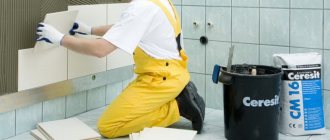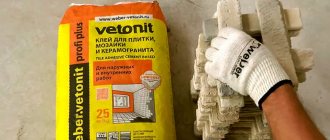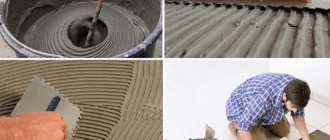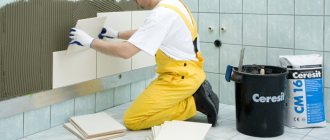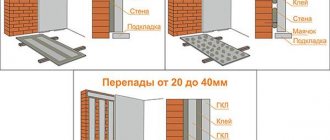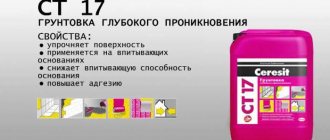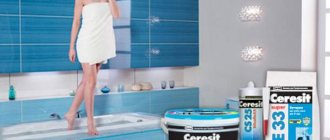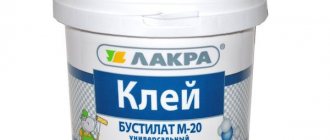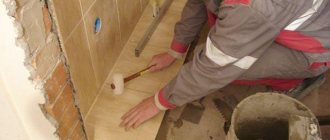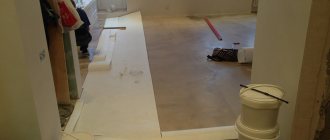Purpose and features
For high-quality laying of tiles on the floor or walls, a whole range of materials is used. All of them are in the Ceresit line, and each has its own marking.
- ST – primers, antifungal impregnations and mixtures for leveling bases.
- CR – waterproofing.
- SM – adhesive compositions.
- SS are elasticizers that impart plasticity to the adhesive.
- SV – mixtures for repairing cladding and replacing damaged tiles.
- CE – grout for tile joints.
Ceresit tile adhesive has several varieties depending on the composition and purpose, but CM 11 is the most popular due to its versatility. In addition to high-grade cement as the main binder, it contains mineral fillers and modifying additives to improve the working properties of the product.
Glue with an elasticizer can be used for cladding surfaces both indoors and outdoors, ceramic, porcelain tiles and natural stone of various formats up to 500x500 mm with a water absorption of 3%.
Fixing large-format tiles with glue Source alonson.com
Note! Without an elasticizing filler and with a lower water absorption capacity of the tile, this composition can only be used for internal cladding of walls and floors without a heating system and high load. For larger tiles, CM 12 adhesive is used.
The basis for cladding can be any durable and stable mineral surface - concrete, brick, cement-sand screed, cement or cement-lime plaster. Including in rooms with high humidity, including bathrooms, showers, swimming pools.
See also: Catalog of companies that specialize in finishing materials and related work
How much does Ceresit decorative plaster cost?
Ceresit plaster is usually packaged in bags. The weight of one bag is 25 kg, and the price, depending on the type of mixture, can vary from 650 to 850 rubles. The manufacturer recommends a consumption of 2.5 to 4 kg/m2. Knowing this, you can calculate the cost of plaster per square meter, as well as the number of bags that need to be ordered for repairs.
Calculation example.
Let the surface area to be plastered be 100 square meters.
m. When applied with a layer of 3 mm (on average), 300 kg of dry mixture, or 12 bags, will be required. With a price per bag of 700 rubles. We find that we need to buy plasters in the amount of 8,400 rubles. The cost in terms of area will be 84 rubles. per sq. m. If applied in a thinner layer, the consumption will decrease accordingly, then the cost per 1 m2 will be less. Ceresit “bark beetle” plaster is sold in many online stores and retail outlets, so compare prices before purchasing to make a profitable order. data-matched-content-ui-type=”image_stacked” data-matched-content-rows-num=”2″ data-matched-content-columns-num=”3″ data-ad-format=”autorelaxed”>
Varieties
Ceresit glue brand CM 11 is available in two varieties - Pro and Plus. These are improved modifications of the base composition with higher rates of adhesion, moisture and frost resistance.
When mixing with just water, it is recommended to use them only on fixed bases indoors. The scope of application is significantly expanded if the elasticizer CC 83 is added to the adhesive composition during mixing, which increases the product’s resistance to shock and variable loads, and the formation of microcracks.
Elastomeric additive for cement adhesive Source uralmegaprom.ru
The use of this additive allows you to:
- use Ceresit SM 11 glue for exterior work;
- veneer unstable surfaces made of plasterboard, chipboard, OSB, cellular concrete;
- glue tiles to fresh concrete bases less than a month old.
Also popular are adhesives of this brand with an increased index.
- CM 115 – white adhesive for mosaic and marble.
- SM 117 – for facade tiles.
Both varieties are suitable for external and internal use without the addition of elastomers.
Surface preparation
The surface must be clean and free of grease before using Ceresit glue. First, the base is cleaned of dirt, paints, fats and oils. If there are significant defects, they are repaired, then the surface is leveled.
Small holes can be leveled with CM 11. When there are significant unevennesses, a day before work you need to use composition SN 72 or SN 83.
Typical bases
Ceramic tiles can be applied to cement and plaster without pre-treatment. Dry surfaces require moisture. In this case, the cement foundation must be equipped at least 28 days before work, and the concrete one - six months before.
On video: Ceresit tile adhesive.
Atypical
Various particle boards and anhydrite bases, gypsum, cellular concrete must first be primed, for which Ceresit ST 17 is suitable. After this, at least 5 hours should pass. Substrates coated with water-dispersed paints with high adhesion, plasterboard panels, bituminous materials, and drywall do not require a primer.
Video description
How to prepare tile adhesive from a dry mixture, watch the video:
Ready-made tile adhesive Ceresit SM 11 has the following characteristics:
- production time when in a high container - 2 hours;
- the permissible time for gluing tiles to glue applied to the surface is 10-15 minutes;
- the permissible time for adjusting tiles on the mortar is 20-25 minutes;
- optimal temperature for work is from +5 to +30 degrees;
- humidity – no higher than 80%;
- the maximum limit for sliding of the cladding on vertical surfaces is 0.5 mm;
- grouting the cladding joints with a standard solution – after 1 day;
- grouting of cladding joints using elastic mortar Ceresit 11 with elasticizer CC 83 – after 3 days;
- adhesion to the base of a standard solution is 0.8 MPa, elastic – 1.3 MPa;
- operation of the cladding is possible in the temperature range from -50 degrees to +70 degrees;
- frost resistance of the solution with elastomer is more than 100 cycles.
The consumption of the finished mixture depends on the evenness of the base, the dimensions of the tiles and the size of the comb teeth for applying the adhesive.
Applying glue with a notched trowel Source kremersand.com
For example, when using small-format tiles with a side length of 10-15 cm, the adhesive composition is applied with a comb-trowel with teeth 0.4-0.6 cm, consuming about 2.5 kg of the mixture per 1 square meter of surface to be tiled. The relief of the adhesive mixture for tiles measuring 30-40 cm is increased to 1 cm, and the consumption increases accordingly - up to 4.2-4.5 kg.
Glue
Tile adhesive is a composition intended for gluing tiles to horizontal and vertical surfaces.
Ceresit glue is famous for the following advantages:
- reliability;
- security;
- environmental friendliness;
- high adhesion;
- frost resistance;
- chemical inertness;
- biological passivity;
- heat resistance;
- excellent moisture resistance;
- the absence of such a phenomenon as sliding;
- ease of application.
There are no disadvantages to Ceresit adhesive mixtures. The scope of application depends on the type of material.
The following types of substance exist:
- Ceresit CM 11 Plus - intended for gluing tiles 40x40 cm or less on mineral surfaces that are not subject to deformation;
- Ceresit SM 12 “Porcelain stoneware” - intended for gluing large floor tiles, but not more than 60x60 cm, on mineral surfaces that are not subject to deformation;
- Ceresit SM 14 “Extra” – intended for gluing ceramics, porcelain tiles, stone up to 45x45 cm on a cement base;
- Ceresit CM 16 – intended for gluing all existing types of tiles to any surface;
- Ceresit CM 17 – intended for gluing all existing types of tiles to any surface;
- Ceresit CM 115 - intended for gluing tiles made of marble, glass mosaics, translucent stones, light limestone on mineral bases that are not subject to deformation;
- Ceresit CM 117 – intended for gluing all types of tiles onto a mineral base that is not subject to deformation;
- Ceresit CM 9 Plus - intended for fastening tiles 30x30 cm and smaller on mineral surfaces that are not subject to deformation.
Instructions for use:
- the work surface is cleaned;
- any flaws are removed;
- a primer is applied to the work area;
- the substance is mixed;
- the mixture is applied to the surface using a spatula;
- the tile is pressed tightly against the area treated with glue;
- the tiles are wiped with a dry cloth;
- a technical break is taken;
- The seams are worn out.
You can brag to your wife and mother-in-law about the work done. Let them evaluate and “tag”!
Anecdote off topic: I love it when the mother-in-law is correct... She doesn’t yell at you, watches football with you, can drink beer after work!.. That’s the father-in-law - the correct mother-in-law!!
Recommendations for use
In order for the adhesive for Ceresit porcelain tiles to exhibit all its properties and hold the cladding as firmly as possible, its use is preceded by preparatory work using other products of this brand.
- Leveling plaster is made with a mixture of Ceresit ST 29, allowing it to dry for 3 days.
- Small wall defects and depressions up to 5 mm deep are eliminated with CM 9 adhesive solution one day before the start of facing work.
- The floors are covered with the leveling mixture Ceresit CH.
- Stable mineral bases are treated with ST 17 primer.
- To strengthen absorbent and deformable bases and screeds on heated floors, use CN94 primer.
Primer Ceresit ST 17 for preparing bases for tiles Source inbud.zp.ua
To distribute the solution, use a notched trowel with square teeth. When finishing internal surfaces, glue is applied only to the base; for external cladding - both to the base and to the back side of the tile.
Note! The adhesive solution has an aggressive alkaline environment, so when working with it, be sure to use protection for the skin and respiratory system.
There is no need to soak the tiles before laying. They are glued with the obligatory installation of tile joints and their subsequent grouting with compounds with CE marking.
Fresh Ceresit 11 glue can be easily wiped off the surface with a wet sponge or cloth; excess protruding in the seams must not be allowed to harden, otherwise the dried solution can only be removed by mechanical cleaning or special solvents.
Specifications
The composition of ceresit ce is based on cement. Additional components include mineral fillers, pigments and polymer-type modifiers. The composition is positioned as water-repellent and resistant to prolonged exposure to water.
Ceresit grout has the following characteristics:
- Resistant to stains. The seams are easy to clean with standard detergents.
- Elasticity. After hardening, the joints are not afraid of deformation.
- Wear resistance. Once applied to the surface, the material will remain there unchanged for about five years.
- Color stability. The seams will not fade or change color under the influence of ultraviolet radiation.
- Enhanced protection against fungus. Due to the special components in its composition, the product protects joints from fungal infection.
- Impeccable smoothness. After hardening, the product will be smooth and pleasant to the touch.
- Ecological cleanliness. The manufacturer ensures that its products are completely harmless to health and the environment.
Colors
Grouting Ceresit comes in different colors. There are 37 different shades in total. This is convenient for buyers, because each house has its own decoration.
The most common color of the material is white. It can be mixed with dyes to allow artists to achieve the perfect shade match.
The seams acquire color after 1-2 days, depending on environmental conditions and the correct application of the mixture. The finished shade of grout may differ slightly from the declared one.
Advantages and disadvantages
Melba Ceresite is sold in almost every hardware store. This is a hydrophobic beige cement-based grout for joints up to 10 millimeters wide.
Prevalence and quality are its main advantages. The disadvantages of Ceresit include its price. It is higher than that of analogues. Other disadvantages include long hardening time and difficulty in color control.
Briefly about the main thing
Among Ceresit brand products intended for tile work, adhesive marked CM 11 is in high demand. This is a universal composition used for cladding vertical and horizontal surfaces in dry and wet rooms, which, when mixed with a special elasticizer, can also be used for outdoor work. This additive also makes it suitable for covering deformable substrates such as plasterboard partitions or wood-based floors.
Ratings 0

